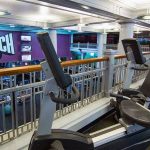Burlington Stores reported earnings on an adjusted basis fell 80.6 percent in the third quarter ended October 31 due to a decline in sales and higher product sourcing costs tied to the pandemic. Comparable store sales decreased 11 percent, with significant improvement coming out of August .
Michael O’Sullivan, CEO, stated, “We were pleased with the progress we made in the third quarter. After a challenging start in August, our comparable store sales trend improved significantly to minus 4 percent in the combined September and October period. During the quarter, there were early signs of progress with our Burlington 2.0 Off-Price Full Potential Strategy, as we chased the sales trends, took advantage of great opportunistic buys, and turned our inventories rapidly. We were able to drive sales and also achieve a very healthy gross margin.”
O’Sullivan continued, “Unfortunately, the outlook remains uncertain and unpredictable – in fact, the situation across the country with COVID-19 appears to be deteriorating. The fourth quarter has gotten off to a weak start with November month-to-date comparable-store sales running down in the low double digits. In this uncertain environment, we will continue to plan and manage our business conservatively. We have significant liquidity, and we will use this to maintain our flexibility to react to the trend, as well as to opportunistically build our reserve inventory.”
Fiscal 2020 Third Quarter Operating Results
(for the 13 week period ended October 31, 2020 compared with the 13 week period ended November 2, 2019)
- Total sales decreased 6 percent to $1,665 million, and comparable-store sales declined 11 percent. Results were ahead of Wall Street’s consensus estimate of $1.55 billion. While sales trends were challenging in August due to deficient inventory levels and delayed back-to-school purchases, comparable-store sales trends improved significantly in the combined September and October time period as inventory levels recovered to more appropriate levels at the end of August and back to school demand improved, particularly in September.
- Gross margin rate was 45.0 percent versus last year’s rate of 42.4 percent. This improvement was driven by a combination of lower markdowns and higher markup, which were partially offset by higher freight costs.
- Product sourcing costs, which are included in selling, general and administrative expenses (SG&A), were $144 million in the third quarter vs. $90 million in last year’s third quarter. Product sourcing costs include the costs of processing goods through our supply chain and buying costs. The increase in product sourcing costs was driven primarily by higher supply chain costs, due to higher wages and hiring incentives.
- SG&A increased $62 million to $645 million for the third quarter of Fiscal 2020. Adjusted SG&A was $495 million vs. $486 million last year, due to higher store-related and corporate costs, partially offset by lower marketing expense.
- The effective tax rate was 65.3 percent versus 19.2 percent in last year’s third quarter. The Adjusted Effective Tax Rate was 49.7 percent versus last year’s third quarter Adjusted Effective Tax Rate of 19.6 percent. The increase in the Adjusted Effective Tax Rate was primarily related to the decreased benefit recorded from estimated net operating losses carried back to five prior tax years, as permitted under the CARES Act.
- Net income was $8 million, or $0.12 per share versus net income of $96 million, or $1.44 per share for the third quarter last year, and Adjusted Net Income represented a profit of $20 million, or $0.29 per share vs. $103 million, or $1.53 per share last year. This decrease in Adjusted Net Income was due primarily to the decline in sales and higher product sourcing costs, in each case driven by the disruptions related to COVID-19. Results on an adjusted basis were ahead of Wall Street’s consensus estimate of 19 cents.
- Diluted shares outstanding amounted to 66.7 million at the end of the quarter compared with 67.2 million at the end of last year’s third quarter. The decrease was primarily the result of share repurchases under the company’s share repurchase program, prior to its suspension. From the end of the third quarter of Fiscal 2019 through the suspension of our share repurchase program announced on March 19, 2020, the company repurchased approximately 0.6 million shares under the program.
- Adjusted EBITDA decreased $79 million from last year’s third quarter to $114 million. Adjusted EBIT decreased $81 million below the prior-year period to $59 million. The decrease in Adjusted EBIT was driven by the same factors described above that drove the decline in Adjusted Net Income.
First Nine Months Fiscal 2020 Results
Total sales decreased 31 percent compared to the first nine months of Fiscal 2019. Net (loss) income decreased 244 percent compared to the prior-year period to $(372) million, or $(5.66) per share vs. $3.84 per share last year. Adjusted EBIT decreased by 235 percent, or $882 million compared to last year, to $(506) million. Adjusted Net (loss) Income of $(333) million was down 219 percent vs. last year, while Adjusted EPS was $(5.05) per share vs. $4.15 per share in the prior-year period.
Inventory
Merchandise inventories were $867 million vs. $1,004 million last year, a 14 percent decrease, while comparable store inventories declined 20 percent. The decrease was driven by the company’s conservative approach to inventory planning due to uncertain consumer demand during the pandemic. Reserve Inventory, which includes all inventory that is being stored for release either later in the season, or in a subsequent season, was 25 percent of total inventory at the end of the third quarter of Fiscal 2020 compared to 19 percent at the end of the third quarter of Fiscal 2019.
Liquidity
The company ended the third quarter with $1,641 million in liquidity, including $1,349 million in unrestricted cash and $292 million in availability on its ABL facility, which continues to have $250 million remaining outstanding at the end of the third quarter.
Share Repurchase Activity
The company suspended its share repurchase program on March 19, 2020. As of the end of the third quarter, the company’s share repurchase program, which remains suspended, had $348 million in the remaining authorization.
Outlook
Given the uncertainty surrounding the pace of the recovery of consumer demand, the company’s sales and earnings guidance for Fiscal 2020 (the 52-weeks ending January 30, 2021) remains suspended at this time.
The following Fiscal 2020 guidance items have been re-issued or updated:
- Capital expenditures, net of landlord allowances, are now expected to be approximately $245 million, which had been reduced at the end of the first quarter from the original outlook of $400 million;
- The company still expects to open 62 new stores, while now relocating or closing 28 stores, for a total of 34 net new stores in Fiscal 2020;
- Depreciation & amortization, exclusive of favorable lease costs, is now expected to be approximately $225 million; and
- Interest expense, net of non-cash interest of $24 million on convertible notes, is now expected to be approximately $75 million.
Photo courtesy Burlington
















